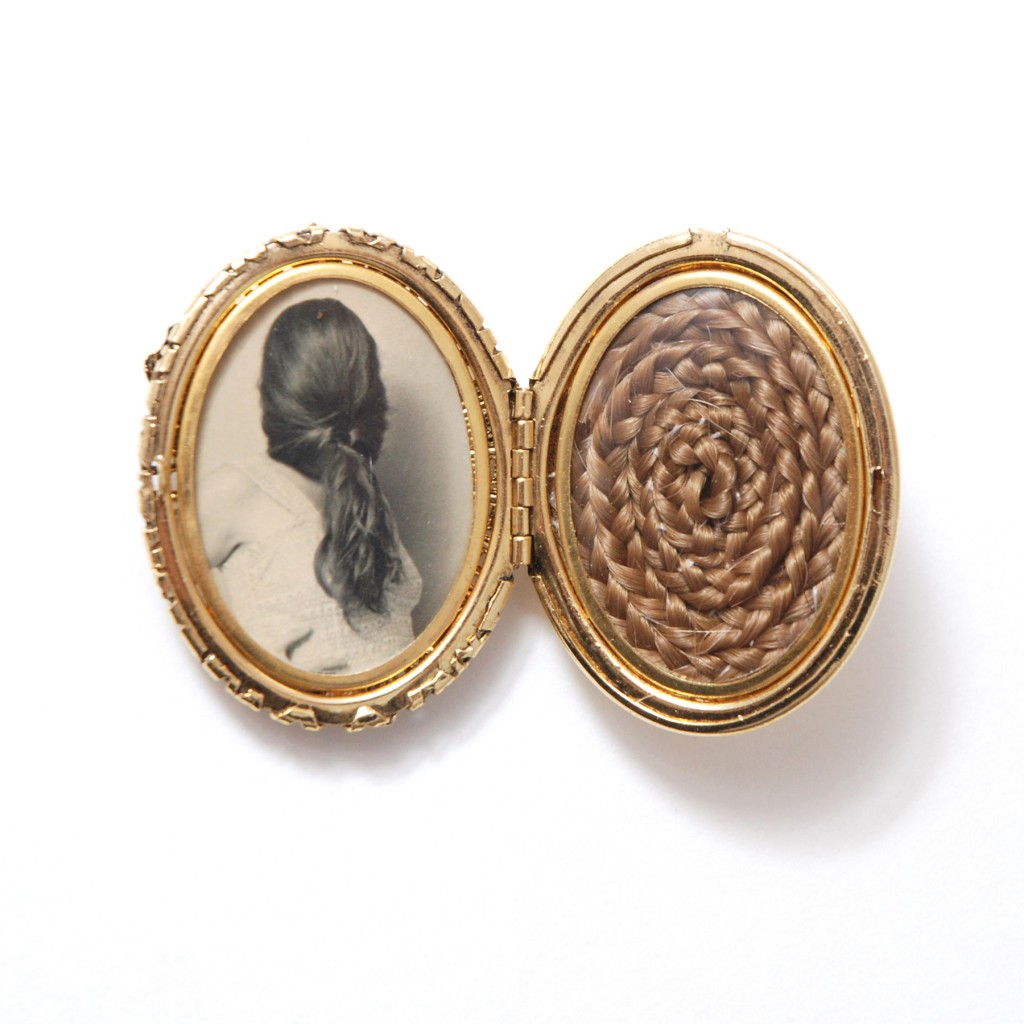Opening Reception
Friday, April 5, 5:30 – 7:00 PM
Houston Center for Contemporary Craft (HCCC) is pleased to present Reminiscential, on view April 5 – May 26, 2013, in the Artist Hall. With the investigation of memory, remembrance and the materialization of these ideas as a common thread, artists Clare Finin, Rebecca Drolen, Robert Thomas Mullen and Deme Wolfe-Power have created distinctive works that pay homage to the rich history of memento mori objects and Victorian sentimental and mourning jewelry. Through the use of materials often regarded as repulsive or grotesque, many works in the show ask viewers to reevaluate and challenge their conventional notions of beauty.
HCCC Curatorial Assistant, Ashley Powell, who curated the show, was captivated by the work: “Objects made to remember someone, something, or sometime are what we use as tangible reminders of the most valuable and ephemeral possessions that make us who we are as individuals. I was inspired by the ways in which these four artists so uniquely materialize their inner thoughts and emotions.”
The jewelry pieces of photographer and mixed-media artist, Rebecca Drolen, present a contemporary interpretation of Victorian sentimental jewelry through the use of human hair, photos, and the intimate nature of lockets and brooches. Sentimental objects containing the hair of a loved one were ubiquitous during that era and served as secular relics and material reminders of moments of loss. (By being worn on the body of the bereaved, these objects were thought to keep the deceased close, as well as wordlessly communicate the person’s loss to others.) Not only does Drolen’s work cleverly comment on these historical pieces, it explores the line between the beautiful and grotesque.
Also drawing inspiration from the use of hair in Victorian sentimental jewelry, Clare Finin creates work using her own hair as thread. She plays on the material’s inherent nostalgic qualities to explore her own history, memories, and the effects these moments had on her life decisions. With hair, imperishable in nature, she employs domestic techniques—rope making, embroidery, crocheting and lace tatting—that were once commonly practiced in her family. In her piece, Learning a Tradition, Finin repaired a tattered doily from a great Aunt, and by learning the same technique her relative used, felt more deeply connected to her family.
The work of Deme Wolfe-Power is clearly evocative of memento mori objects, which appeared sometime in the 16th century and never quite disappeared. (Memento mori is a Latin phrase that translates to “Remember your mortality” or “Remember you will die.” These objects, which often used skull motifs, human hair and dead animals, generally did not refer to a specific person but served as a reminder of the transitory nature of life.) Wolfe-Power uses this genre to create unforgettable jewelry with the intention of questioning contemporary perceptions of beauty. Her work juxtaposes precious and semi-precious metals and stones typically used for adornment with materials often seen as repulsive—human teeth, taxidermy bird anatomy, human hair and animal hides. By pushing these boundaries, she firmly asks, “In what context does something that was natural or beautiful become repulsive?”
The work of metalsmith and photographer, Robert Thomas Mullen, examines the human tendency to collect items of sentimental value: souvenirs from vacations, jewelry from mothers and grandmothers, and other tokens that provide proof or clues to a memory or a person’s existence. By incorporating an array of found objects with personal meaning, such as human teeth and hair, animal fur, and insects, Mullen makes highly individual brooches that reference historical sentimental objects. Each piece is suffused with nostalgia, telling a special story and serving as a visual archive of his memories and time spent in different locations.
(1) Rebecca Drolen, “Chin Hair.” Photograph, found object, hair. 2012. Photo by Rebecca Drolen. (2) Rebecca Drolen, “Spiral.” Photograph, found object, hair. 2012. Photo by Rebecca Drolen. (3) Rebecca Drolen, “Tweezings.” Photograph, found object, hair. 2012. Photo by Rebecca Drolen. (4) Clare Finin, “Fractures.” Family porcelain, human hair. 2012. Photo by Abby Johnson. (5) Clare Finin, “Learning a Tradition.” Family heirloom, human hair. 2012. Photo by Abby Johnson. (6) Clare Finin, “Place Setting #1.” Linen placemat, human hair. 2012. Photo by Abby Johnson. (7) Robert Thomas Mullen, “Fossil/Matrix Brooch #11.” Copper, resin, human tooth, bronze, quartz. 2012. Photo by Robert Thomas Mullen. (8) Robert Thomas Mullen, “Fossil/Matrix Brooch #18.” Cherry, resin, fish vertebrae, driftwood, steel, pearls. 2012. Photo by Robert Thomas Mullen. (9) Robert Thomas Mullen, “Fossil/Matrix Brooch #22.” Oak, resin, deer tooth, fossilized amber, bee. 2012. Photo by Robert Thomas Mullen. (10) Robert Thomas Mullen, “Fossil/Matrix Brooch #26.” Copper, wool, powder coating, pearls. 2012. Photo by Robert Thomas Mullen. (11) Deme Wolfe-Power, “Crows feet necklace.” Oxidized White metal , black CZ’s, Crows foot. 2012. Photo by Deme Wolfe-Power. (12) Deme Wolfe-Power, “Frame Series- Mouse skin brooch.” Oxidized White metal (silver), 18k gold, black CZ’s, steel pin, Mouse fur and tail. 2012. Photo by Deme Wolfe-Power.

